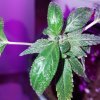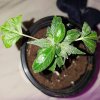Peyote alexia
Well-Known Member
Hey guys.
I've been cloning for a while now. Not a seasoned veteran but I love experimenting. I find it half the fun. In my current location I battle fungus and mould. And not the good type. I've managed to settle it. By introducing the good type (another thread) but it's always there. If you've heard story's of cyanobacteria you know how tuff this stuff is. It's will survive in chlorinated water indefinitely. It seems to feed it. Well my theory.
Is chlorine does kill some off. But then the ravagous pathegons multiply further by feeding from there own dead organics. And any other organics you've pasteurized for an easy meal for them.
There's plenty of pathogens depending on where your from. But this method may apply for most bad stuff. I've got 100% success rate through basic cloning methods. Using tap water and cloning gel. (in your preferred medium it doesn't matter) then once at the one week point I saturate them with tap water (chlorinated) every other day. And at the 10 day mark even the most stubborn will root.
Basic
Now to the water cloning test. A friend clones his tomato with this very basic method. So I tested it with a easy to clone plant that was 1 week and a bit into flower. It needed trimming anyway.
So I cut about 6 clones and dipped only one in the cloning gel. Then all 6 into a cup of chlorinated tap water. Leave the initial cup untouched for 2 days and let the cloning gel soak into the water and the other cuttings. Then change the water daily. Just with cold tap water. And I mean its winter so they are getting 25°c down to 10°c at every change
5 days later. The cutting that was dipped has started rooting. And the little root bumps have developed on the others so they will follow suit. Anyway here's some pics. I think changing the water daily makes a massive difference. Even if the pathogens are able to multiply. They are brought back down to a suitable level every day


I've been cloning for a while now. Not a seasoned veteran but I love experimenting. I find it half the fun. In my current location I battle fungus and mould. And not the good type. I've managed to settle it. By introducing the good type (another thread) but it's always there. If you've heard story's of cyanobacteria you know how tuff this stuff is. It's will survive in chlorinated water indefinitely. It seems to feed it. Well my theory.
Is chlorine does kill some off. But then the ravagous pathegons multiply further by feeding from there own dead organics. And any other organics you've pasteurized for an easy meal for them.
There's plenty of pathogens depending on where your from. But this method may apply for most bad stuff. I've got 100% success rate through basic cloning methods. Using tap water and cloning gel. (in your preferred medium it doesn't matter) then once at the one week point I saturate them with tap water (chlorinated) every other day. And at the 10 day mark even the most stubborn will root.
Basic
Now to the water cloning test. A friend clones his tomato with this very basic method. So I tested it with a easy to clone plant that was 1 week and a bit into flower. It needed trimming anyway.
So I cut about 6 clones and dipped only one in the cloning gel. Then all 6 into a cup of chlorinated tap water. Leave the initial cup untouched for 2 days and let the cloning gel soak into the water and the other cuttings. Then change the water daily. Just with cold tap water. And I mean its winter so they are getting 25°c down to 10°c at every change
5 days later. The cutting that was dipped has started rooting. And the little root bumps have developed on the others so they will follow suit. Anyway here's some pics. I think changing the water daily makes a massive difference. Even if the pathogens are able to multiply. They are brought back down to a suitable level every day






